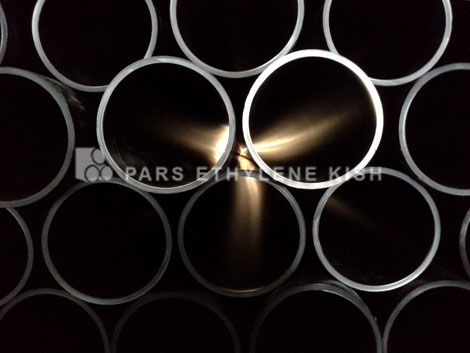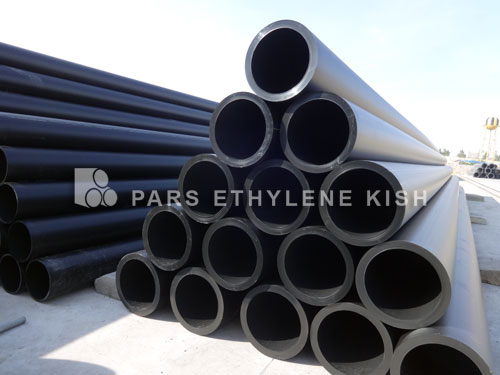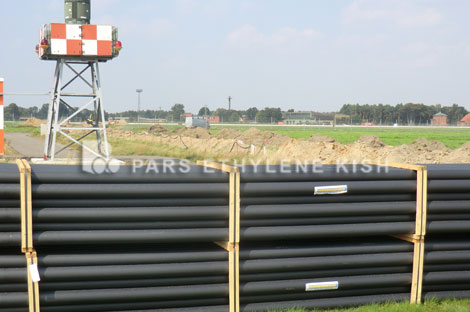
Storage, maintenance and handling of single-wall polyethylene pipes
Storage and maintenance of HDPE pipes
Due to the limited production of polyethylene pipes in terms of work pressure, diameter, accessories, fitting type and production capacity, it is necessary to identify these constraints and comply with the requirements of the design through making contacts with the manufacturers and before making the final pipe selection.
Note: The following guide applies to all types of polyethylene pipes in general, but is more commonly used for single-wall polyethylene pipes. See the link below for Guide On Transportation and Storage of Double-Wall Corrugated Pipes.
- Guide on storage, maintenance and transportation of double-wall corrugated polyethylene pipes

Transportation and handling of polyethylene pipes
The contractor is required to take ultimate precaution in loading, unloading, storage and maintenance the polyethylene pipes, so that no damage occurs. Lifting and lowering pipes and accessories should be done slowly. When carrying, use trucks with flat surface free of sharp things. If pipes are supplied as packaged in the factory, wide bands should be used when lifting and avoid using chains, hooks, or other hardwires. To indicate how these packs are to be handled, use power distributor beams for pipes with more than 6 meters in length. The contractor should not roll polyethylene pipes on the ground. The contractor should not push pipes on metal rails or wooden lumber to transfer pipelines to a lower surface, and must be careful not to hit or scratch them during handling. At the same time, the contact of the pipe wall with metal fittings and sharp stones should be prevented as these will cut the walls. If the pipe and accessories are moved at temperatures below zero degrees, the contractor must ensure that the pipe and accessories do not collide or collapse with hard objects, as they will break them. when transporting in wet or frosty conditions, care must be taken that due to the slippery surface of the pipes, no injury occurs. The contractor must make sure that pipes stored in rolls, are not untied on a hard surface, and uniting is performed so that the roll of the pipe is not deflected or damaged.
Packaging polyethylene pipes
Generally, polyethylene pipes are manufactured according to the production conditions and length and other requirements of the applicant in two ways: coils or pipes. Coils can be stacked together and pipes are loaded with conventional inhibitors on the truck flat bed. The standard length commonly used for pipe loading in most cases is approximately 40 inches, although pipes with a length of 60 inches are also produced. The common cross section size for transportation systems is 20 inches. Although these regulations are not a comprehensive standard, they can be changed to local conditions and project locations. If these limitations are not taken into account, fines resulting from breach of laws will increase shipping costs. Weight limitations, which are also among the limiting factors in the transportation of products, are less likely to occur due to the light weight of polyethylene pipes, but this should always be taken into consideration.
Figures shows a general example of the method of loading and transportation, and packaging conditions. Although the actual conditions may be different from the example given, small fittings are generally packaged in cartoons or portable packages, which, if the amount of these cartoons is high, the use of special pallets to load and move is recommended. When pipes are loaded in coils, small pieces of fittings can be placed between the coils. Tanks, manholes or large or fully-ordered parts are always loaded and transported separately on the flat bed.

Polyethylene pipes packaging and delivery confirmation
It is important to note that the content and proposed solutions proposed by the author should not replace the current instructions of your system, but managers and employers should address these points as complementary tips. Executives and project managers generally have instructions for counting or delivery of goods that only it shall be mentioned that the bill of lading and the purchase request must necessarily correlate in terms of the number of items and the description of the goods. After the initial counting and matching of the goods received with the purchase request or design documentation, the goods shall also be inspected in terms of quality and health in that they might be damaged at the time of loading and transportation. Apparent defects, such as deep incisions, abrasions, scratches, tearing, or perforations, should be thoroughly inspected and verified.
Polyethylene pipe unloading training
 Perhaps the issues described in this topic seem to be simple and primitive, but these points have often been repeatedly experienced in executive projects, and attention to them prevent the increase in the time and cost of projects, and the failure to observe these obvious points might causes physical damages. Before unloading, it must be ensured that there is a flat surface approximately as tall as the load surface, where the trailer must be leveled with; and its wheels must be blocked by physical obstacles. The equipment and tools used for unloading should be capable of safe unloading and the possibility of load displacement, and in this regard, they should be in line with the capacity and tonnage of the load.
Perhaps the issues described in this topic seem to be simple and primitive, but these points have often been repeatedly experienced in executive projects, and attention to them prevent the increase in the time and cost of projects, and the failure to observe these obvious points might causes physical damages. Before unloading, it must be ensured that there is a flat surface approximately as tall as the load surface, where the trailer must be leveled with; and its wheels must be blocked by physical obstacles. The equipment and tools used for unloading should be capable of safe unloading and the possibility of load displacement, and in this regard, they should be in line with the capacity and tonnage of the load.
Note: Unloading or loading should be planned and operated in a completely safe environment. If these measures are not considered, there will be consequence but no financial and life-threatening damage. In this case, unnecessary people are not required to be present at the loading or unloading place. In addition, the use of trained and skilled forces in this process is strongly recommended.
Requirements for polyethylene pipe unloading locations
As previously stated, the unloading location should be completely flat and sufficiently large so that there is the possibility of moving the goods and also enough space to unload the goods there. Pipes, packs and pallets are generally unloaded from one side of the trailer and by the liftruck. However, in the case of unpacked pipes, bulky connections or manholes and tanks, a crane performs unloading. These parts must previously be secured and fixed by straps or ropes. Bands and ropes, or inhibiting cables, must be in line with the weight and capacity of the crane, and the use of timeworn cables is not recommended. There are comprehensive guide on the use of cranes for loading and unloading, that we recommend to be carefully studied in advance. The implementation of these guide protects you against potential risks.
Loading equipment
The use of appropriate loading and unloading equipment should be in accordance with the load capacity and its dimensions, and in this case it is necessary to use and pay attention to the safety recommendations. Note that pipes must not be thrown or rolled down from the trailer. Observing this point with regard to fittings, manholes and tanks is also necessary and it is necessary to prevent throwing them. When using cranes for lifting loads, bands and cables must be used in accordance with the capacity and the bands must be adjusted with the load’s center of gravity. The lift truck driver removing the load from the floor should pay attention that this center of gravity is placed in the middle of the forks of the liftruck. Carrying unbalanced and slippery loads should be avoided. Before lifting the load by the liftruck, it should be noted that the forks must be fully placed under the load and the liftruck driver should pay attention to the load capacity and the strength of the liftruck.
Controlling the entrance of the polyethylene pipe to the workshop
The pipe at the factory site will be monitored by quality assurance methods. Production controls are beyond these specifications and should be done independently. The contractor must pay attention to the following points at the time of delivery of polyethylene pipes to the workshop and, meet with the consulting engineer if there are any deficiencies.
• The total amount of cargo shipped shall be controlled with the bill of lading in terms of quantity.
• Any shortage of pipe or accessories should be included in the receipt along with a list of possible damages.
• The list of damaged pipes and the list of defects in the shipments shall be immediately prepared and reported.
Maintenance of polyethylene pipes
The contractor is required to stockpile and maintain the pipe and accessories that are provided to him for the operation of the contract, in order to prevent damage, and in any case, the contractor will be responsible for the maintenance of pipes and fittings. In this case, the following key points are required by the contractor:
• Keep pipes and accessories in a cool place away from direct sunlight. If the length of storage is long, pipes and accessories are covered with dark cloth.
• Keep pipes and accessories in a local warehouse with suitable for ventilation and prevent the accumulation of hot air around the pipe and its accessories.
• Keep pipes and accessories away from heat sources or hot items, such as heaters, boilers, or powerhouses.
• If polyethylene pipes are placed on top of each other, pipes must be completely parallel to each other to prevent bending and deflection, and the height of the pipes thus stored should not exceed one meter.
Storing separated pipes
• Accessories should also be regularly arranged on shelves and, in the case of accessories for large pipes, storage should be in such a way that accessories are not placed on each.
• Polyethylene pipes and accessories should be kept away from harmful chemicals.
• With necessary measures, prevent the entry of soil and external materials into pipes, fittings and valves.
• If the pipes are damaged due to inappropriate storage, the damaged part should be completely cut off and not used.
• Allocating space for storage of all types of pipes, valves and fittings should be in such a way that that the goods that are used earlier are placed in the front parts so that removing them from the warehouse is easily done without the need to move the rest of the goods. To this end, the contractor must provide a regular program for the storage of pipes, fittings and valves, and this program should be appropriate to the progress of the executive operation.
• Smaller pipes stored as coils can be placed flat on each other or placed on the edge of the board. The maintenance and maximum height of coils are shown in the following figure.
• If pipes are shipped to the workshop with special caps to prevent contamination, these caps should remain on the pipe until the end of the storage.
Note: The above guide is generally applicable to all types of polyethylene pipes, but is most commonly used for single-walled polyethylene pipes. Refer to the link below to guide on transportation and storage of double-wall pipes.





